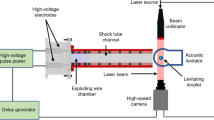Abstract
HERE we report that the addition of small quantities of high molecular weight, water-soluble polymers to water (in our case polyacrylamide) increases the rate of vibratory cavitation erosion of copper. This result, together with that of Kudin1, who obtained an enhanced rate of jet cutting after a similar addition, strengthens the analogy drawn between the two processes, and indicates that microjets may play a significant role in cavitation damage. These results may well be relevant for rain erosion, a process often compared with cavitation and jet cutting.
Similar content being viewed by others
References
Kudin, A. M., et al., Nature, 245, 95 (1973).
Mitchell, T. M., and Hammitt, F. G., Trans. Am. Soc. mech. Engrs, J. Fluid Engng, 95, 29 (1973).
Kling, C. L., and Hammitt, F. G., Trans. Am. Soc. mech. Engrs, J. bas. Engng, 94, 825 (1972).
Ting, R. Y., U.S. Nat. Bur. Standards, Spec. Publ. 394, 100 (1974).
Ting, R. Y., J. appl. Polym. Sci., 16, 3169 (1912).
Plesset, M. S., Trans. Am. Soc. mech. Engrs, J. bas. Engng, 92, 807 (1970).
Wilson, R. W., and Graham, R., Proc. Conf. on Lubric. and Wear (Inst. mech. Eng 1957).
Author information
Authors and Affiliations
Rights and permissions
About this article
Cite this article
ASHWORTH, V., PROCTER, R. Cavitation damage in dilute polymer solutions. Nature 258, 64–66 (1975). https://doi.org/10.1038/258064a0
Received:
Accepted:
Issue Date:
DOI: https://doi.org/10.1038/258064a0
- Springer Nature Limited
This article is cited by
-
Cavitation–silt erosion in sand suspensions
Journal of Mechanical Science and Technology (2018)
-
Dynamics and Breakup of Viscoelastic Liquids (A Review)
Fluid Dynamics (2005)
-
Formation of damage pits by cavitation in a polymer solution
Nature (1986)
-
Polymer effects on microjet impact and cavitation erosion
Nature (1976)





